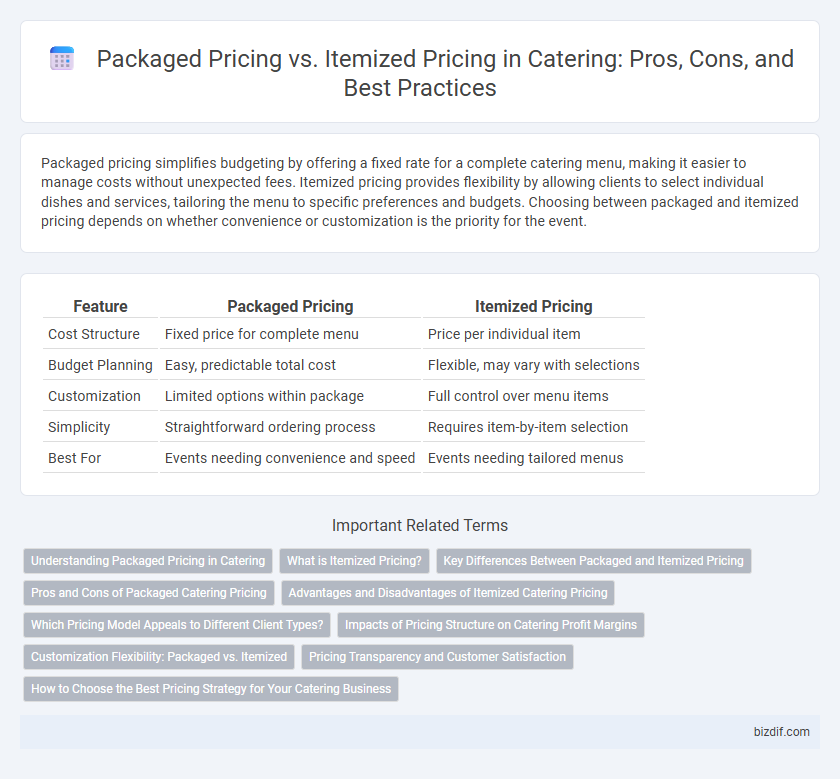Packaged pricing simplifies budgeting by offering a fixed rate for a complete catering menu, making it easier to manage costs without unexpected fees. Itemized pricing provides flexibility by allowing clients to select individual dishes and services, tailoring the menu to specific preferences and budgets. Choosing between packaged and itemized pricing depends on whether convenience or customization is the priority for the event.
Table of Comparison
| Feature | Packaged Pricing | Itemized Pricing |
|---|---|---|
| Cost Structure | Fixed price for complete menu | Price per individual item |
| Budget Planning | Easy, predictable total cost | Flexible, may vary with selections |
| Customization | Limited options within package | Full control over menu items |
| Simplicity | Straightforward ordering process | Requires item-by-item selection |
| Best For | Events needing convenience and speed | Events needing tailored menus |
Understanding Packaged Pricing in Catering
Packaged pricing in catering offers a comprehensive cost structure that bundles food, beverages, service, and sometimes rentals into a single, all-inclusive fee. This pricing model simplifies budget planning by providing clients with a clear total cost upfront, reducing the risk of unexpected charges. Understanding packaged pricing enables event organizers to efficiently compare options and make informed decisions based on value and convenience.
What is Itemized Pricing?
Itemized pricing in catering breaks down the cost of each component, such as appetizers, main courses, desserts, beverages, and service fees, providing transparency for clients. This pricing model allows customers to select specific menu items and services tailored to their budget and preferences, ensuring clarity on where expenses are allocated. Catering companies use itemized pricing to offer customizable packages and detailed invoices, enhancing trust and satisfaction.
Key Differences Between Packaged and Itemized Pricing
Packaged pricing in catering offers a bundled set of services and menu items at a fixed rate, simplifying budgeting and decision-making for clients. Itemized pricing breaks down costs for each component, providing transparency and flexibility to customize orders according to specific preferences. The key difference lies in packaged pricing's convenience and predictability versus itemized pricing's detail and adaptability for personalized catering experiences.
Pros and Cons of Packaged Catering Pricing
Packaged catering pricing offers clients a clear, fixed cost that simplifies budgeting and reduces the risk of unexpected expenses, making it ideal for events with strict financial constraints. This pricing model streamlines decision-making by bundling menu items, service, and sometimes extras into one package, though it limits customization and may include items clients don't want. Event organizers benefit from the convenience and cost predictability of packaged pricing, but the lack of flexibility can reduce satisfaction if specific dietary preferences or unique requests are not accommodated.
Advantages and Disadvantages of Itemized Catering Pricing
Itemized catering pricing offers transparent cost breakdowns for each menu item, allowing clients to customize orders according to budget and preferences. This detailed approach can lead to better cost control but may result in higher overall expenses due to individual item markups and complexity in comparing total prices. However, itemized pricing provides flexibility, enabling clients to make informed decisions while potentially increasing administrative workload for caterers.
Which Pricing Model Appeals to Different Client Types?
Packaged pricing appeals to clients seeking simplicity and predictability, such as corporate clients and event planners managing fixed budgets and timelines. Itemized pricing attracts clients who prioritize customization and flexibility, including weddings and private parties where specific menu choices and personalized services are essential. Understanding client preferences helps caterers tailor pricing strategies to meet diverse demands effectively.
Impacts of Pricing Structure on Catering Profit Margins
Packaged pricing simplifies customer decisions by bundling menu items into a single price, often enhancing perceived value and increasing sales volume, but it can limit profit margins if costs aren't carefully controlled. Itemized pricing offers detailed cost transparency, allowing precise markup on each menu component, which can optimize profit margins but may deter budget-conscious clients with perceived complexity. Catering businesses must analyze food costs, labor expenses, and client preferences to select a pricing structure that maximizes profitability while maintaining competitive appeal.
Customization Flexibility: Packaged vs. Itemized
Packaged pricing offers limited customization as clients choose from preset menu bundles, streamlining decision-making but restricting personalized options. Itemized pricing enhances customization flexibility by allowing clients to select individual dishes and services, tailoring the catering experience to specific preferences and dietary requirements. This granular approach often leads to more precise budgeting and satisfaction for events with unique or diverse guest needs.
Pricing Transparency and Customer Satisfaction
Packaged pricing in catering offers clear, upfront costs that enhance pricing transparency by bundling services into a single, easy-to-understand fee, reducing unexpected charges and simplifying budgeting for customers. Itemized pricing provides detailed cost breakdowns for each service or food item, allowing clients to customize their orders and understand exactly what they are paying for, which can increase customer satisfaction through perceived fairness and control. Both pricing methods impact customer satisfaction differently, with packaged pricing appealing to those who value simplicity and itemized pricing attracting clients who prioritize transparency and customization.
How to Choose the Best Pricing Strategy for Your Catering Business
Selecting the best pricing strategy for your catering business hinges on understanding customer preferences and operational costs. Packaged pricing offers simplicity and predictability by bundling menu items into set offerings, appealing to clients seeking convenience and fixed budgets. Itemized pricing provides flexibility and transparency, allowing customers to customize orders while enabling caterers to manage ingredient costs and maximize profit margins effectively.
Packaged Pricing vs Itemized Pricing Infographic

 bizdif.com
bizdif.com